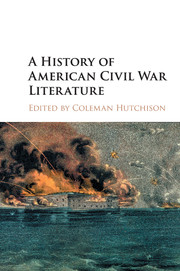Book contents
- Frontmatter
- Dedication
- Contents
- List of Illustrations
- Notes on Contributors
- Preface
- Acknowledgments
- Part I Contexts
- Part II Genres
- 6 Dépôt Culture: The Civil War and Periodical Fiction
- 7 Imitation and Resistance in Civil War Poetry and Song
- 8 Children's Literature
- 9 Writing Lives: Civil War Diaries
- 10 Civil War Memoir
- 11 Civil War Narrative History
- Part III Figures
- Recommendations for Further Reading
- Index
11 - Civil War Narrative History
from Part II - Genres
Published online by Cambridge University Press: 05 December 2015
- Frontmatter
- Dedication
- Contents
- List of Illustrations
- Notes on Contributors
- Preface
- Acknowledgments
- Part I Contexts
- Part II Genres
- 6 Dépôt Culture: The Civil War and Periodical Fiction
- 7 Imitation and Resistance in Civil War Poetry and Song
- 8 Children's Literature
- 9 Writing Lives: Civil War Diaries
- 10 Civil War Memoir
- 11 Civil War Narrative History
- Part III Figures
- Recommendations for Further Reading
- Index
Summary
Looking back in 1961 on the America that had gone to war with itself a hundred years before, Bruce Catton saw leaders and citizens who were tragically incapable of comprehending their historic moment. “This was a time when most men were purblind,” he wrote in his ominously titled work The Coming Fury. “Neither side believed that the other side was deeply in earnest, and neither side was prepared to face the consequences of its own acts.” Clarity of vision could only come with the passage of time, and in the years before Catton wrote, any number of historians had tried to explain the motives, aims, events, and circumstances that had led to that difficult era and its (possibly) unforeseeable bloodshed.
Needless to say, historians have kept at the task in the half-century since Catton penned those words. The Civil War is by far the most written about event in the nation's history, and estimates suggest that there are significantly more than 50,000 books devoted to the conflict. There has been a barrage of military accounts, and Abraham Lincoln has proven an inexhaustible subject for biographers. There have been histories of single years, single campaigns, single battles, and single days of single battles. There are “private” and “inner” versions of the Civil War to balance out the public ones, as well as studies from any number of racial, ethnic, gender, and national perspectives. Virtually every aspect of the war has at least one book devoted to it, and there are few periods of American history that we know as much about.
This impressive tradition of scholarship has done more than document a pivotal period in the nation's history. Considered as a collective and ongoing body of work, it also reflects the many ways in which the United States changed during the 150 years that followed Appomattox. Every generation since the war has had its own interpreters of the conflict, and their works of history have tended to tell two stories rather than just one. The war of the 1860s is fought again and again on their pages, moving through a familiar series of defeats and triumphs. But these scholars almost always offer a portrait of their own times as well, dwelling on the preoccupations and prejudices of their present moments even as they turn to the past.
- Type
- Chapter
- Information
- A History of American Civil War Literature , pp. 165 - 178Publisher: Cambridge University PressPrint publication year: 2015



